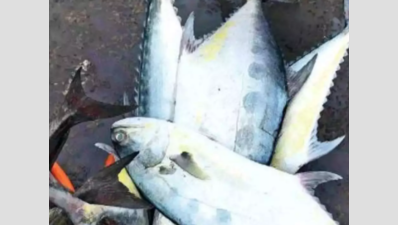- News
- City News
- kochi News
- Zinc, lead… fish in Kochi estuary are ‘heavy’, daily intake risky
Trending
Zinc, lead… fish in Kochi estuary are ‘heavy’, daily intake risky
Heavy metals like zinc, cadmium, and chromium contaminate fish and shellfish in Kochi's estuary, posing health risks. Research emphasizes the need for regular monitoring and risk assessment of heavy metals in seafood resources for environmental protection and human health.

Representative image
KOCHI: As water flow during non-monsoon period decreases in Kochi's estuary, high levels of carcinogenic heavy metals zinc, cadmium and chromium is found in several fish and shellfish, making their daily consumption a threat to human health.
Water, sediment and biota exhibited high concentration of heavy metals and crossed the toxicity thresholds, says a latest study carried out by a team of researchers at the Marine Biology Department of Cochin University, National Centre for Coastal Research, and Ministry of Earth Sciences.

The research focused on several species of fish commonly found in the area, including Manangu, Kayalkatla, Karimeen, Poolameen, Nachukarimeen, Chundan Koori, Karipetty, Kanambu, Poozhan, Para, Karachemmeen, Kavalan Njandu, and Karutha Kakka.
It is found that chromium had the highest accumulation in herbivores, and cadmium in filter feeders like fish, clams, etc. Cadmium and lead exceeded the standards of the Food Safety and Standards Authority of India and the Food and Agriculture Organization.
The year-long study was on wild populations of fish and shellfish. The samples were collected from the south, central and north zones of the estuary during premonsoon, monsoon and postmonsoon periods. The fish species were selected due to their prevalence in the estuarine environment and their economic significance, based on commercial value and consumption. Samples were obtained from fishers, was hed several times using distilled water, placed in an icebox, and sent to the laboratory for further treatment and examination. The collected samples included 10 fish species, two crustacean species, and two bivalve species. The extracts were analyzed for copper, zinc, lead, cadmium, manganese, nickel and chromium.
The research team led by senior professor and Kannur University vice-chancellor S Bijoy Nandan called for urgent need for regular monitoring and risk assessment of heavy metals, especially lead, cadmium, and chromium, in seafood resources across coastal areas.
Implications of this study extend beyond scientific discourse, raising awareness among policymakers, regulatory agencies, and coastal communities about the critical importance of environmental stewardship and sustainable management practices. Efforts to mitigate heavy metal contamination in coastal ecosystems must be prioritized to safeguard both ecological integrity and human health, it said.
Water, sediment and biota exhibited high concentration of heavy metals and crossed the toxicity thresholds, says a latest study carried out by a team of researchers at the Marine Biology Department of Cochin University, National Centre for Coastal Research, and Ministry of Earth Sciences.

The research focused on several species of fish commonly found in the area, including Manangu, Kayalkatla, Karimeen, Poolameen, Nachukarimeen, Chundan Koori, Karipetty, Kanambu, Poozhan, Para, Karachemmeen, Kavalan Njandu, and Karutha Kakka.
Neethu K V, lead author of the study which was published recently in Springer Online, said: “Unlike previous studies, we looked at this analysis as a human health risk and our tests focused on that. Long-term consumption of food that has such heavy metals that are carcinogenic and a threat to human health is a concern that we tried to bring forth.”
It is found that chromium had the highest accumulation in herbivores, and cadmium in filter feeders like fish, clams, etc. Cadmium and lead exceeded the standards of the Food Safety and Standards Authority of India and the Food and Agriculture Organization.
The year-long study was on wild populations of fish and shellfish. The samples were collected from the south, central and north zones of the estuary during premonsoon, monsoon and postmonsoon periods. The fish species were selected due to their prevalence in the estuarine environment and their economic significance, based on commercial value and consumption. Samples were obtained from fishers, was hed several times using distilled water, placed in an icebox, and sent to the laboratory for further treatment and examination. The collected samples included 10 fish species, two crustacean species, and two bivalve species. The extracts were analyzed for copper, zinc, lead, cadmium, manganese, nickel and chromium.
The research team led by senior professor and Kannur University vice-chancellor S Bijoy Nandan called for urgent need for regular monitoring and risk assessment of heavy metals, especially lead, cadmium, and chromium, in seafood resources across coastal areas.
Implications of this study extend beyond scientific discourse, raising awareness among policymakers, regulatory agencies, and coastal communities about the critical importance of environmental stewardship and sustainable management practices. Efforts to mitigate heavy metal contamination in coastal ecosystems must be prioritized to safeguard both ecological integrity and human health, it said.
End of Article
FOLLOW US ON SOCIAL MEDIA










